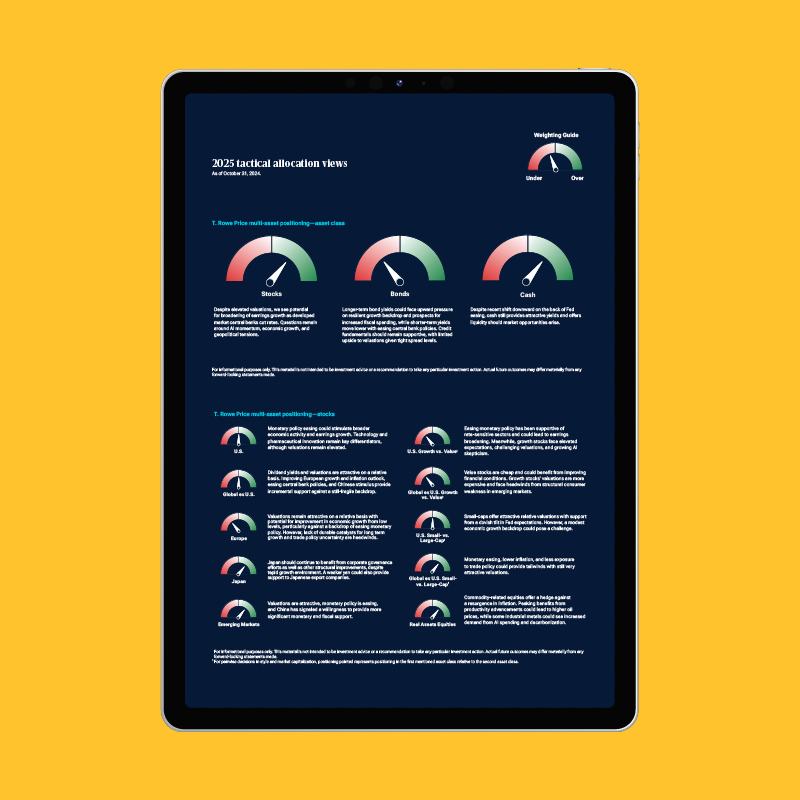 Investing During Transition
Investing During Transition
2025 Global Market Outlook
The world is transitioning at a pace and scale rarely seen before. Radical innovations in artificial intelligence (AI) and healthcare. Elevated geopolitical tensions, including the raised posibility of tariffs following the U.S. elections. A potential slowdown in global growth. Times like these demand actionable insight and the skill of active management. Here’s what to know to navigate the shifts and opportunities ahead.

Watch the webinar
Hear our investment experts’ dynamic perspective on the state of markets and the economy heading into 2025. Continuing education (CE) credits available for financial professionals.
Financial Advisors/Intermediaries - CE available
A destination for all our clients
I want to explore mutual funds, roll over my 401(k), save for college, get investment advice or open a new account.
I’m an institutional investor or consultant looking to review investment strategies and discover timely insights.
I’m looking to access my employer-sponsored retirement program.
I’m a broker-dealer, registered investment advisor, DC–focused advisor, or trust or bank financial professional.
I'd like to learn more about T. Rowe Price, the company, its culture and business priorities.
I’m looking to access my retirement plan or gain insights on retirement plan strategies.
I'm looking for information on Alternative Credit Investments.
This document reflects the views of the respective associates of T. Rowe Price Associates, Inc., and certain of its investment advisory affiliates. Where noted (articles "U.S. Equities" and "Private Markets"), the views expressed are those of associates of T. Rowe Price Investment Management, Inc., and Oak Hill Advisors, L.P, respectively. The views expressed in this material may differ from the views of other associates and/or T. Rowe Price group companies. T. Rowe Price Associates, Inc. (TRPA), and T. Rowe Price Investment Management, Inc. (TRPIM), have separate research platforms and make investment decisions independently. Oak Hill Advisors, L.P. (OHA), an alternative credit manager, is a T. Rowe Price company.
Views are the opinions of the Global Market Outlook authors as of November 15, 2024.
Financial Terms: For a Glossary of financial terms, please go to: www.troweprice.com/en/us/glossary
Investment Risks:
Active investing may have higher costs than passive investing and may underperform the broad market or passive peers with similar objectives. Each persons investing situation and circumstances differ. Investors should take all considerations into account before investing.
International investments can be riskier than U.S. investments due to the adverse effects of currency exchange rates, differences in market structure and liquidity, as well as specific country, regional, and economic developments. The risks of international investing are heightened for investments in emerging market and frontier market countries. Emerging and frontier market countries tend to have economic structures that are less diverse and mature, and political systems that are less stable, than those of developed market countries.
Equities have higher risk and are subject to possible loss if principal. Investing in technology stocks entails specific risks, including the potential for wide variations in performance and usually wide price swings, up and down. Technology companies can be affected by, among other things, intense competition, government regulation, earnings disappointments, dependency on patent protection and rapid obsolescence of products and services due to technological innovations or changing consumer preferences. Financial services companies may be hurt when interest rates rise sharply and may be vulnerable to rapidly rising inflation. Health sciences firms are often dependent on government funding and regulation and are vulnerable to product liability lawsuits and competition from low-cost generic product.
The value approach to investing carries the risk that the market will not recognize a security’s intrinsic value for a long time or that a stock judged to be undervalued may actually be appropriately priced. Growth stocks are subject to the volatility inherent in common stock investing, and their share price may fluctuate more than that of a income-oriented stocks.
Small‑cap stocks have generally been more volatile in price than the large‑cap stocks.
Investing in private companies involves greater risk than investing in stocks of established publicly traded companies. Risks include potential loss of capital, illiquidity, less available information and difficulty in valuating private companies. They are not suitable, nor available, for all investors.
All investments involve risk, including possible loss of principal. Diversification cannot assure a profit or protect against loss in a declining market.
Fixed‑income securities are subject to credit risk, liquidity risk, call risk, and interest‑rate risk. As interest rates rise, bond prices generally fall. Investments in high‑yield bonds involve greater risk of price volatility, illiquidity, and default than higher‑rated debt securities. Investments in bank loans may at times become difficult to value and highly illiquid; they are subject to credit risk such as nonpayment of principal or interest, and risks of bankruptcy and insolvency. Because of the nature of private credit there may be heightened risks for investors, such as liquidity risk and credit risk to the underlying borrower and investments involve greater risk of price volatility, illiquidity, and default than higher-rated debt securities.
T. Rowe Price cautions that economic estimates and forward‑looking statements are subject to numerous assumptions, risks, and uncertainties, which change over time. Actual outcomes could differ materially from those anticipated in estimates and forward‑looking statements, and future results could differ materially from any historical performance. The information presented herein is shown for illustrative, informational purposes only. Any historical data used as a basis for this analysis are based on information gathered by T. Rowe Price and from third‑party sources and have not been independently verified. Forward‑looking statements speak only as of the date they are made, and T. Rowe Price assumes no duty to and does not undertake to update forward‑looking statements.
Additional Disclosures
For more information on Third Party Market Data please visit troweprice.com/marketdata.
Important Information
This material is provided for informational purposes only and is not intended to be investment advice or a recommendation to take any particular investment action.
The views contained herein are those of the authors as of November 2024 and are subject to change without notice; these views may differ from those of other T. Rowe Price associates. This information is not intended to reflect a current or past recommendation concerning investments, investment strategies, or account types, advice of any kind, or a solicitation of an offer to buy or sell any securities or investment services. The opinions and commentary provided do not take into account the investment objectives or financial situation of any particular investor or class of investor. Please consider your own circumstances before making an investment decision.
Information contained herein is based upon sources we consider to be reliable; we do not, however, guarantee its accuracy.
Past performance is not a reliable indicator of future performance. All investments are subject to market risk, including the possible loss of principal. All charts and tables are shown for illustrative purposes only.
T. Rowe Price Investment Services, Inc., distributor, T. Rowe Price mutual funds. T. Rowe Price Associates, Inc., and T. Rowe Price Investment Management, Inc., investment advisers. T. Rowe Price Investment Services, Inc., T. Rowe Price Associates, Inc., and T. Rowe Price Investment Management, Inc., are affiliated companies.
© 2024 T. Rowe Price. All Rights Reserved. T. ROWE PRICE, INVEST WITH CONFIDENCE, and the Bighorn Sheep design are, collectively and/or apart, trademarks of T. Rowe Price Group, Inc.
ID0007462
202412-4108437





